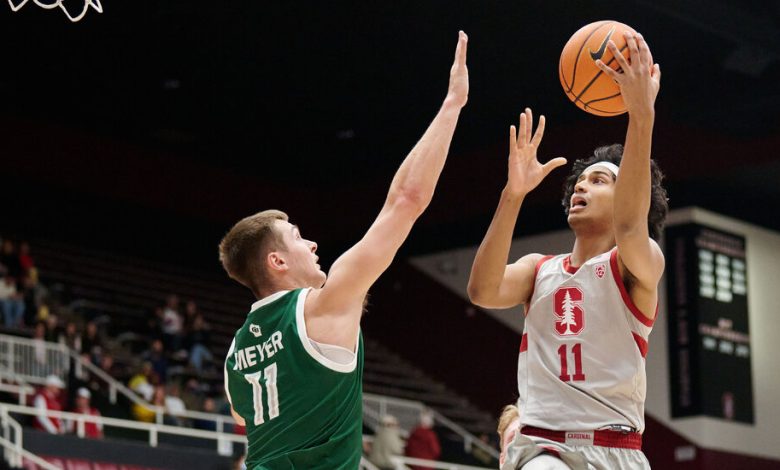This Stanford Freshman Wants His Play to Represent India

STANFORD, Calif. — The arena in Frisco, Texas, is only a 30-minute drive from Ryan Agarwal’s hometown near Dallas. But for a middle-school-age Agarwal, stepping inside was like entering another world.
In 2015, Agarwal was a sixth grader obsessed with basketball. So that year, when the Dallas Mavericks made Satnam Singh the first Indian-born player selected in an N.B.A. draft, Agarwal knew he had to go see him compete. On a trip two years later with his cousin and father to watch Singh in an N.B.A. G League game, Ryan Agarwal realized he wanted to play like Singh himself.
Agarwal’s parents had emigrated from India, and he was born in a Dallas suburb. He said he had never seen someone who looked like him playing basketball and had therefore never considered taking the game seriously. It was watching Singh, he said, that made him believe he could play at a high level.
“It was just excitement for him to connect with someone he can see is like himself,” Ashok Agarwal, Ryan’s father, said.
Six years later, Ryan Agarwal is much farther from home — 1,700 miles away at Stanford University, where he is a freshman shooting guard trying to bolster the Cardinal’s faltering offense. He’s still chasing Singh, hoping to pick up where Singh left off in representing India in the American basketball landscape while playing the sport in college.
“I just have to keep in mind the fact that I help represent such a big community, and only so little people have the ability to do what I’m trying to do,” Agarwal said recently on the sideline of a Stanford practice.
Agarwal said he didn’t shy away from a certain amount of pressure that comes with people judging an entire culture based on his play. The high school talent evaluator Rivals.com rated him as a four-star recruit, among the best 150 players in his class. When the time came for Agarwal to announce where he would play in college, he chose to share the spotlight not just with the coaches and relatives who helped him get there, but with India. In a video with dramatic music set to a montage of him walking along train tracks, Agarwal voiced his intention “to set an example for a whole heritage and prove that we can do it, too.”
“The commitment video that he did was his thought process, his message that he wanted to say,” his mother, Ranjini Agarwalla, said. “It was not anything that we even talked about. So we were shocked when he brought that up and said, ‘This is what I want to do.’”
That Agarwal was even recruited out of high school was notable. Only 2 percent of Division I student-athletes identified as Asian in the 2021-22 school year, according to N.C.A.A. statistics. Agarwal’s parents said that as he was growing up, it wasn’t always clear how they should proceed through the rigorous world of recruiting and elite sports.
“For us, everything was a learning experience,” Ashok Agarwal said.
Now, families reach out to them to ask for advice, Ranjini Agarwalla said, partly on how to encourage their children in sports and get them noticed by college coaches.
“I’m blessed with the parents I have, because they put me in every sport possible to just try to see what I love, which honestly, not a lot of Indian parents do,” Ryan Agarwal said. “I think that’s the biggest thing for me. If it wasn’t for the support from my parents, who knows where I would be.”
So far this season, Agarwal has come off the bench for Stanford in nearly two-thirds of its games, averaging roughly 8 minutes when he plays. Rivals.com once ranked Agarwal as a top-20 shooting guard, but Stanford Coach Jerod Haase said he considered Agarwal a more complete player because of his size at 6-foot-6 and his passing ability.
“He’s going to be really good,” Haase said.
Just how good remains to be seen. For now, Agarwal’s efforts are focused on helping Stanford (11-15) find its footing in a competitive Pac-12 Conference.
The only player of Indian descent to have logged N.B.A. minutes is the Canadian-born Sim Bhullar, who wasn’t drafted but played in three games for the Sacramento Kings during the 2014-15 season. Bhullar now plays in Taiwan.
Singh, billed as a “one in a billion” player in a Netflix documentary, was unable to make it in the N.B.A. He failed to gain traction in the G League, playing only two seasons with the Texas Legends, and never appeared in an N.B.A. game.
Since the N.B.A. opened an academy in India in 2017, 20 graduates have earned scholarships either to prep schools or junior colleges in the United States, or signed professional contracts, according to Mark Pozin, a spokesman for the league.
Zach Reynolds, a spokesman for Stanford, said that when he was trying to figure out how many players of Indian descent played Division I men’s basketball, he and other sports information directors around the country were able to come up with three: Agarwal, center Amaan Sandhu of Monmouth and the Penn State walk-on player Ishaan Jagiasi.
At Stanford’s first home game of the season, 1,500 students from Palo Alto, Calif., elementary and middle schools filed into the stands at Maples Pavilion. Haase said Agarwal took pride in setting an example for kids who were just starting to imagine their futures, like Agarwal was when he watched Singh in Frisco in 2017.
“There’s probably a lot of those kids who didn’t realize these goals are achievable,” Haase said. “Even if it’s just coming to a game and seeing someone like Ryan, I think he takes great pride in being that beacon of, ‘Hey, work hard, have fun while you’re doing it, and there’s some great things that can happen.’”
